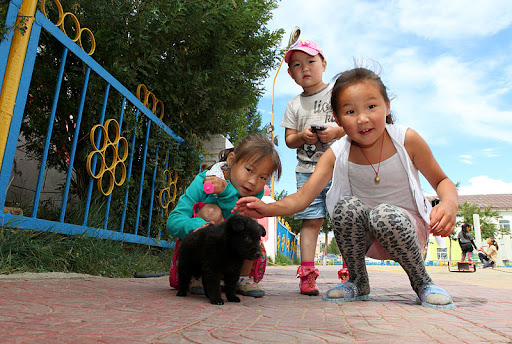[아시아 취학 전 교육① 몽골] 게르유치원 “유목민 아이들 모여라”

교육과 훈육은 0세부터 시작된다고 합니다. 이를수록 효과가 높다는 얘기지요. 취학 전 아이들 교육에 대한 관심이 큰 까닭입니다. 사회주의를 택했던 중앙아시아 일부 국가에선 유치원 교육을 정부가 100% 맡는 나라도 있습니다. 몽골이나 이란의 유목지역에선 정부와 지자체가 유치원 교육을 앞장서고 있습니다. ‘과열’이 아니라 ‘제대로 된 방향’이겠죠? 아시아 각국의 취학 전 교육을 살피며 우리의 현실을 되돌아봅니다. <편집자>
[아시아엔=돌고르 춘룬바타르 아시아기자협회 부회장] 몽골은 세계에서 가장 낮은 인구밀도를 보이고 있다. 3백만여명의 인구 중에 대략 30%(약 130만명)가 유목민이다. 이들은 이동식 전통 천막인 유르트에서 생활한다. 유르트는 게르(ger)라고도 알려져 있다. 보통 유목민 가족들은 서로 5~15km 정도 떨어져서 지낸다.
낮은 인구밀도와 광활한 대륙 그리고 한 여름 영상 40도에서 겨울철 영하 50도를 오르내리는 극심한 온도차는 물자운송과 같은 공공서비스가 제한적이어서 주거 비용이 많이 들어갈 수밖에 없다. 이같이 불리한 자연환경은 역설적으로 몽골의 유치원 교육 발달에 기여하게 됐다. 즉 이동식 유치원과 같이 유목민 아이들도 이용할 수 있는 대체교육이 정착하게 된 것이다.
게르 유치원은 특정지역에 붙박이로 있는 유치원에 부속해서 운영된다. 게르 유치원은 두 개의 천막이 세트를 이룬다. 하나는 수업용 교실로 쓰이며, 다른 하나는 식사와 취침용이다. 교실 안에는 키가 낮은 책상과 의자, 학용품과 낮잠용 침대 매트가 있다. 각각의 게르 유치원은 1세에서 5세 아이들을 수용할 수 있다. 이동식 게르 유치원은 여름에만 운영한다.
유치원이 운영되는 지역은 따뜻한 여름에 유목민들이 어디로 이동하느냐에 따라서 결정된다. 게르 유치원은 픽업 트럭에 천막을 싣고 유목민들이 10~15가구 모여 사는 지역으로 이동해 설치된다. 게르 유치원은 서너 시간 안에 뚝딱하고 세울 수 있다. 유치원 교사들은 게르 유치원이 이동하는 시골이나 외딴 지역에 함께 이동하며 아이들을 가르친다. 순전히 유목민 아이들의 교육편의를 위해서다.
게르 유치원은 일반학교의 여름방학 기간인 6월에서 시작해 8월까지 운영된다. 통상 여름 이외의 계절에는 운영되지 않는다. 선생님들은 유치원이 운영되는 동안 게르에 머물며 아이들을 가르친다. 부모나 친척들은 아침에 아이들을 데려다 등교시킨 후 늦은 오후에 아이들을 데리러 온다. 하지만 가끔은 밤 동안에도 선생님들에게 맡겨 두는 경우도 있다.
게르 유치원은 통상 3~6주 동안 같은 곳에 머물지만, 가끔은 유목민들을 따라 이동하기도 한다. 이들 게르 유치원 선생님들의 봉급과 추가 발생 비용은 모두 몽골 교육부가 부담한다. 추가 발생 비용의 경우 정부가 재원을 마련해주기도 하지만 매우 제한적이다. 따라서 유치원 스스로 자선행사 등을 통해 유치원 가구와 학용품 등을 구입해 쓰기도 한다.
유목민 가족들은 매우 외딴 지역에 거주하는 까닭에 게르 유치원은 유아기 교육 지원뿐 아니라 아이들이 서로 어울리면서 사회성을 기르도록 하는 것도 중요한 교육목표가 되고 있다. <번역 이상기 기자>

Yurt kindergarten, a Mongolian innovation of alternative ECE services for the nomadic children
Mongolia has the lowest population density in the world with just 1.7 persons per square kilometer of land. With a population of around 3 million people, roughly 30% are nomadic herders living in portable traditional yurt known as ger. The nomad families are usually live 5-15 km away from each other.
Given the country’s sparse population and wide geographical spread, and the extreme climate conditions- with temperatures ranging from 40 degrees to minus 50 degrees Celsius- constrain not just the operational and logistical aspects of public service delivery, but also contribute to higher costs of providing services.
In addition to the conventional fixed kindergartens, these factors have led Mongolia to the creation of alternative preschool programs: traveling teachers, mobile or ger kindergarten, and shift classes to reach herder’s children.
Ger kindergartens are managed by the regular fixed kindergartens they are attached to. Each ger kindergarten comprises two gers. One is for teaching and learning, and the other is for cooking and sleeping. Inside the classroom, there are low tables and chairs, learning materials, and bed mats for napping.
Each ger-kindergarten is intended to accommodate around 20-25 children aged between 1-5 years. Mobile ger kindergartens operate in the summer only, and reach out to herders in locations where they tend to move to during the warmer summer months. The gers are loaded in a pick-up truck and driven to the countryside location where about 10-15 herding families can be found close to each other. It takes Mongolians a couple of hours to set up a typical ger. The ger kindergartens, along with teachers, are transported to rural and remote areas that are more easily accessible for herders and where their children are able to attend the kindergarten daily.
The kindergartens start operations after the summer recess begins from June and ends in August. The teachers stay in the ger for the duration of its operation. Parents or relatives bring children in the morning and fetch them in the late afternoon, but may sometimes leave children with teachers overnight. The kindergarten will stay in the same location for three to six weeks, and sometimes will move with the herders to follow them.
Ger kindergarten services are not typically offered outside the summer months. Ministry of Education covers the cost of teacher salaries and other recurrent expenses, typically providing an operating budget of 21 days. Very limited supplementary resources from soum governments may be available to some kindergartens. In some cases, the gers themselves, along with the furniture and learning materials in them, were procured through donor-financed projects.
Herders’ families are usually resident in a very isolated environment, the ger kindergartens provide not only early childhood education, but also the opportunity for children to socialize with other children.





